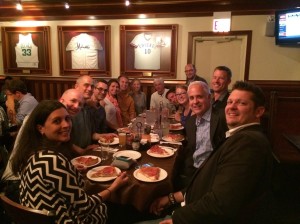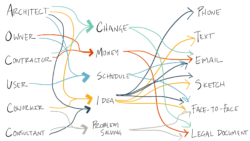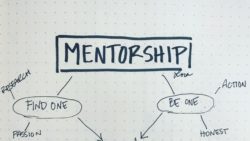Finding a mentor
Mentorship is a weird thing. Depending on the career season, economical climate, location, job type, etc…the ability to find a mentor can vary widely. It’s important to realize, though, that there is one piece of the mentorship puzzle that’s not dependent on something beyond your control: effort. No one wants to mentor someone who doesn’t care or doesn’t work hard to better himself/herself. It’s a two-way street, remember? You get out of mentorship what you put in.
Now…*steps off soapbox*…let’s talk about those variables and how you can work with them to find a mentor or 5. Because it’s hard to talk about something you haven’t experienced, I’m sticking to the details of my journey. Yours will be different, but the ideas are the same.
The Mentor Journey
When I moved back to Indianapolis in the summer of 2013, I had been out of grad school for just over 3 years. As most people would attest, 2010 was not a great year to enter the workforce. Add onto that a marriage, 5 cross-country moves, and an impending divorce…I was severely lacking in the mentor department. The constant moving in a down economy had forced me to get creative with work and experience and, as a result, made it hard to find mentors. I was lucky to meet Allison and John when I was in Mississippi, but that luck was preceded by continuous hard work and persistent follow-up calls and emails.
All of this to say: when I moved back in 2013, it was a completely blank slate in front of me. I sat down and thought about what I wanted my future to look like and what I needed to learn and do to get there. I read Steven Covey’s book and started planning. I was still testing towards my license and looking for work. I wasn’t sure what type of architecture I wanted to practice or where I wanted to end up…or if I wanted to take L² full time – which would require clients I didn’t currently have. I *had*, however, been reading enough business books
to know I needed a consistent “face” – or brand presence. So I started setting up the platforms to use L² as that face. If I ended up taking it full time and going out on my own, the ground work was already started; if not, I still had a presence. More on this later.
In this time, I re-connected with Deb. We had overlapped at a previous work setting but worked in different areas of the company. On my return to Indianapolis and watching the architecture market, I knew she was someone I could learn a great deal from.
Tip #1: The best potential mentor is someone you want to emulate. They are doing good work – that interests you – which you have a desire to learn. Typically the best mentors are in the trenches, working hard, and ultimately accessible to you.
I reconnected with Deb at a monthly AIA meeting. I was very new to the AIA, still learning how it worked and making connections in the Indy market. Deb was/is very invested in the AIA, had recently been honored and welcomed into the College of Fellows, and had also recently opened up her own business that was tracking amazing success already. [Those are 3 major positives, if that wasn’t clear.] More than that, she understood hard work and was open to teaching. This is why I call her a rock star. It took overcoming a lot of nervous butterflies in the initial stages of growing this relationship, but the best of mentors have been in your shoes – and remember how it felt.
Tip #2: Remember that your mentor is human. They were your age and your experience level once. Desire to imitate is the sincerest form of flattery. Unless your potential mentor is a curmudgeon – in which case you need to rethink this pairing – they will be thrilled to teach someone what they’ve learned.
But also remember that they’re human in the sense that they will have other things to do. They didn’t get to be a mentor-quality professional by doing nothing, which means they are probably very busy. Value their time and treat it, and them, kindly. Put in effort to listen, learn, and enact what they teach. Don’t just leech onto them and expect them to do all of the work for you.
At the same time I was making these local connections, I was creating a digital foundation/face. I searched Twitter for people talking about architecture. If they were providing consistent, interesting content – I followed them. If they seemed to get a lot of interaction, I paid closer attention. I noticed who interacted and who the “thought leaders” followed. I dove in.
Tip #3: Go for it. Especially on Twitter. The half-life of a tweet from a relatively unknown account is less than 3 minutes. What you think is an awkward conversation starter is a blip in the digital radar of a leader or active participant. Say hi. Interact. It may take more than one comment, be persistent (but not stalker-ish). Put good content out there in the meantime and continue to interact intelligently. You’ll get noticed.
Twitter is where I initially “met” most of my other mentors. Use this platform to your advantage. It’s easier for most people to ask questions and learn from the anonymity of the internet. [It’s also easy to act like a doofus. Don’t do that.] My interactions led to digital friendships and access to knowledge. When you have the combined brains of Bob, Jeff, Marica, Mark, etc at your disposal, you don’t take it lightly. These digital interactions led to a “meet up” at my first AIA Convention where I got to meet and learn from these mentors in person and forge real-life friendships.
Tip #4: If you have a chance to go to a national convention, do it. All the brains converging in one place is not to be passed on without good reason.
Those digital and local (post-digital) relationships require constant fostering. I pay attention to what they’re doing and learn from them. I ask questions when they arise, some subjects more often than others. I pass along articles or things I think they might find interesting and try to be generally helpful. This once again circles back to effort. Your mentor is not your mule. You are the mule; they are the guide. The hope is that the mentor has previously found the path that leads to the next camp (ie: whatever you’re trying to learn), instead of you wandering aimlessly through the canyons like the dumb donkey you are. Don’t take it personally, we’re all dumb donkeys at some point. I still wander fruitlessly more frequently than I’d like to admit.
The point is, if you know the path or direction you hope to aim, an open and honest relationship with your mentor(s) will typically get you there. It may be that “there” changes definition mid-journey, but with a mentor or 5 to guide you and a good work ethic, you’re in good hands no matter the challenges ahead. Good luck, we believe in you. We’re here for you.
Until next time,






